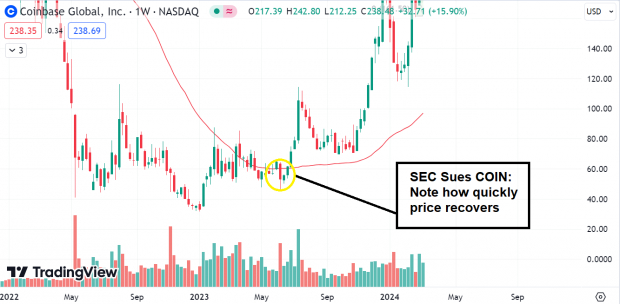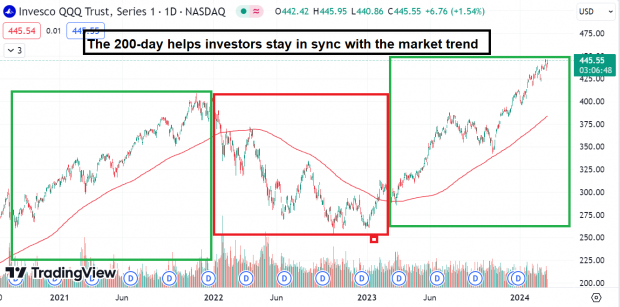Below is part 2 of my series “Real-World Investing vs. Theoretical Investing.” If you missed part 1, you can find it here.
Real World Investors Look for Subtle Clues
Below are two of my most relied-upon clues:
The Reaction to the News Supersedes the News Itself: In late 2023, the SEC sued Coinbase (COIN). Rather than succumbing to poor news, the stock rallied back to where it was pre-lawsuit announcement within days. Investors should focus on the reaction to news instead of the news itself.

Image Source: Zacks Investment Research
Relative Strength: Relative strength is a simple but effective measure of a stock’s potential. Simply put, investors should look for stocks showing unusual divergence versus the general market (this works especially well in down markets because RS names are easier to identify). For example, when equities hit multi-year lows in 2022, Super Micro Computer (SMCI) knocked on the door of 52-week highs. Ask yourself: “If the stock is hitting new highs in a brutal bear market, what will happen when the market pressure is alleviated?” SMCI went on to multi-bag over the next few months and hasn’t turned back since.

Image Source: Zacks Investment Research
Successful Trading is About Having an Edge Over a Series of Trades
Peter Brandt’s motto is:“Strong opinions, weakly held.”
New investors are typically unconcerned with the investing process and want to focus on finding a “hot” stock pick. Successful trading is not about any given trade but rather about having an edge over a series of trades (like a casino).
In an interview a few years ago, billionaire investor Paul Tudor Jones explained his risk/reward framework:
“Five to one means I’m risking one dollar to make five. What five to one does is allow you to have a hit rate of 20%. I can actually be a complete imbecile. I can be wrong 80% of the time, and I’m still not going to lose.”
Lesson: Investors can be wrong more than right and still make a fortune on Wall Street. Shoot for outsized winners and small losers, and the math will work over time. Pay attention to the simple math behind successful trading!
Interpret vs. Predict
Last year, nearly every Wall Street analyst was wrong in their predictions. Real-world investors understand the importance of flexibility and focus on interpreting the current market action rather than making grandiose and bold predictions about the future.
Market Direction is Paramount
Most investors feel genius in a bull market and dumb in a bear market. The cold, hard truth is that about 75% of stocks follow the market direction. What separates profitable investors from unprofitable investors is their ability to recognize and take advantage of trend change. The 200-day moving average is a simple but effective tool for monitoring the intermediate to long-term market trend.

Image Source: TradingView
Know Your Timeframe
Amateur investors often do not know their time frames. Without a framework, it’s impossible to understand the trend of the stock you are trading. Worse, many investors argue on social media about a specific stock. The truth is that one investor can be long while another investor is short, and they can both be correct (due to differing time frames)! Knowing and sticking to your time frame is critical to success!
Being Right vs Making Money
Years ago, two billionaire adversaries got into a public dispute on CNBC and took opposite sides of a trade. Bill Ackman shorted Herbalife (HLF), citing thatit was a pyramid scheme and he would hold his short “until the end of the Earth” if necessary. Meanwhile, Carl Icahn bought tons of HLF shares and forced a short squeeze. Ackman ultimately threw in the towel and lost nearly $1 billion on the HLF trade after Icahn forced a classic short squeeze.
Recently, Ackman took to X (formerly Twitter) to point out that his fundamental thesis about HLF after stock cratered recently was correct. Nonetheless, discussing whether you’re right on a trade you lost money on is futile. Successful trades have three characteristics:
1. Correct on direction.
2. Correct on timing.
3. Profitable
Ackman was correct on the fundamental thesis, yet he lost money. Correct trades are trades that are profitable, full stop. Never let your ego tell you otherwise.
The Best Investors are Even Keel
In studying my and other’s investing histories, the biggest portfolio drawdowns occur after large upside moves in equity curves. The best investors never get overly-emotional about wins or losses. Furthermore, if you find yourself celebrating like you just won the Superbowl, you’re probably trading a position size that is far too large.
Bottom Line: Simplicity is the Ultimate Sophistication (Focus on the Intangibles)
Instead of overcomplicating investing, savvy and profitable investors keep things as simple as possible. They understand liquidity (never fight the Fed), the general market trend (75% of stocks follow it), and are hyper-focused on risk and sound money management above all else. Remember, profitability is more important than academic history, prestigious awards, or sounding intelligent.
4 Oil Stocks with Massive Upsides
Global demand for oil is through the roof... and oil producers are struggling to keep up. So even though oil prices are well off their recent highs, you can expect big profits from the companies that supply the world with "black gold."
Zacks Investment Research has just released an urgent special report to help you bank on this trend.
In Oil Market on Fire, you'll discover 4 unexpected oil and gas stocks positioned for big gains in the coming weeks and months. You don't want to miss these recommendations.
Download your free report now to see them.Super Micro Computer, Inc. (SMCI) : Free Stock Analysis Report
Herbalife Ltd (HLF) : Free Stock Analysis Report
Coinbase Global, Inc. (COIN) : Free Stock Analysis Report
To read this article on Zacks.com click here.
The views and opinions expressed herein are the views and opinions of the author and do not necessarily reflect those of Nasdaq, Inc.


